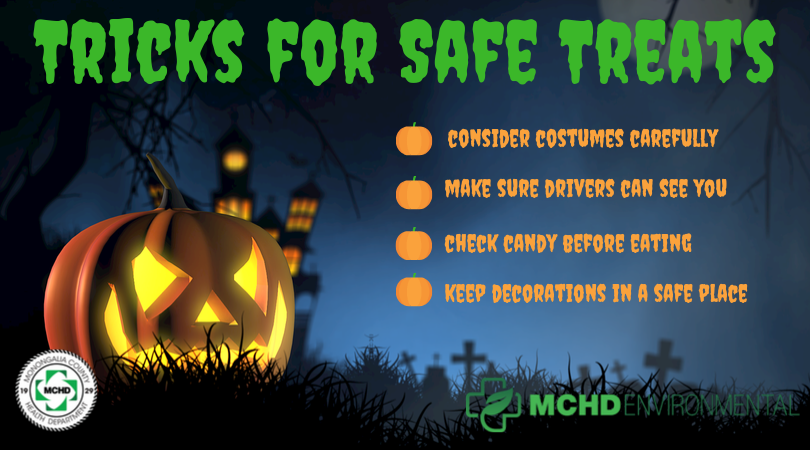Tricks to get your Halloween treats safely

Oct. 30, 2019
By Kenzie Bostick
When people think of October, images that come to mind include cooler weather, pumpkin patches, corn mazes, haunted houses, hayrides, and, most importantly, Halloween. While Halloween is known for being scary fun, these tricks, provided by the Centers for Disease Control and Prevention, can help prevent any real scares while celebrating.
One of the first steps in celebrating Halloween for many people is choosing a costume. Whether you prefer your costumes to be scary, funny, historical or based on the latest pop culture trend, it is important to consider your safety when dressing up to celebrate. If you will be walking at night, remember to add reflective accessories and walk facing traffic so that drivers can see you more clearly. The costume should fit well to prevent falling or blocking your vision. Many costumes include fake weapons or props, but they can cause actual harm if they are not soft and flexible.
Face paint is a common part of costumes, but not everyone’s skin can handle it. Be sure to test face paint and makeup on a smaller area of skin before you apply it all over your face. Costume makeup can irritate the skin if it is left on too long, so always remove it before you go to bed. Some people like to go the extra mile and wear decorative contact lenses to complete their costume; be aware that these contacts can seriously injure the eyes.
Many people enjoy spending their Halloween trick-or-treating. While part of the fun of trick-or-treating is walking around to different houses to get candy, never go alone. Always walk in groups or with an adult, and never enter a house by yourself.
When going from house to house, carry a flashlight with you so that people can see you clearly, and always look both ways before crossing the road to walk to the next house. It can be harder for drivers to see people walking at night, so stay as far away from the road as possible and try to only walk on sidewalks, if possible. Consider applying reflective tape to your costume.
Once you’ve been to every house, then comes the fun part of eating all of the candy you collected. For small children, some candies given out on Halloween can pose a risk of choking. Always look through your candy and remove anything that looks like it may be a choking hazard, as well as anything that might have been tampered with. Treats given out should always be in the original wrapper and should never be homemade.
It also can be tempting to eat all of the good candy that night, but this can leave you feeling not so great. So it is important to pace yourself and eat the candy in moderation.
Halloween may be known for candy, but it doesn’t have to be completely unhealthy. Instead of candy, consider giving out healthier alternatives. Think small boxes of raisins. If you’re hosting a party, offer your guests healthy food, such as a fruit or vegetable tray. Not only can trick-or-treating earn you lots of treats, it is also a great source of exercise. It can be a win-win-win situation: more walking, more exercise, more candy.
Halloween is one of those holidays where many people go all out for decorating. Some people prefer to keep it simple and carve jack-o-lanterns, while others turn their home into a full-scale haunted house. No matter your preference, always keep any candles and lights in places where children and pets cannot reach them, nobody can trip over them or accidentally catch their costume on fire. Strobe lights are a common decoration that can be found in most haunted houses, parties and homes. These kinds of lights are not safe for many people to look at due to medical conditions, so it is important to take this into consideration when decorating.
With these tips, you can be sure to have a fun, safe Halloween full of good scares and tasty treats.
Kenzie Bostick is a public information intern at Monongalia County Health Department.